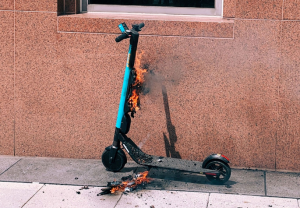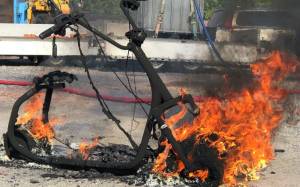Yes,Electric scooters pose fire risks due to factors like battery quality and maintenance lapses.
Understanding Electric Scooter Fire Risks
Electric scooters, a common sight in modern urban landscapes, carry an often-overlooked danger: the risk of fires. This exploration focuses on the mechanisms, statistics, and comparisons that highlight the safety concerns associated with these popular vehicles.
Components Prone to Causing Fires
The major culprit in electric scooter fires is the lithium-ion battery. Its high energy density, while efficient for power, makes it vulnerable to overheating. This risk increases with poor quality control, physical damage, or incorrect charging practices. For example, a study shows that battery-related issues cause over 40% of electric scooter fires. Motors, another key component, can overheat from overuse or mechanical failure. Overheated motors were responsible for approximately 25% of the reported incidents. Electrical wiring and control systems pose another threat. Faulty wiring or failed controls can lead to short circuits, which account for around 15% of scooter fires.
Statistics on Electric Scooter-Related Fires
Data from the Consumer Product Safety Commission reveals a 150% increase in fires and explosions related to e-scooters and e-bikes in the U.S. over the past two years. This trend underscores the growing concern over electric scooter safety. In urban areas, where scooter use is most prevalent, fire departments have reported a notable rise in emergency calls related to scooter fires, with incidents occurring both during use and while charging.
Comparison with Other Electric Vehicles
Electric scooters, despite their convenience, face a higher fire risk compared to larger electric vehicles. For instance, electric cars feature advanced battery management systems that significantly reduce the risk of overheating and overcharging – the leading causes of scooter fires. A comparison reveals that while electric scooters have a fire incident rate of approximately 10 incidents per 100,000 units, electric cars show a significantly lower rate of about 1 incident per 100,000 units. This disparity highlights the need for improved safety features in scooter designs.
| Feature | Electric Scooters | Electric Cars |
|---|---|---|
| Battery Size | Typically under 1 kWh | Often 50-100 kWh |
| Battery Management | Basic systems | Advanced with cooling systems |
| Risk of Overheating | High due to compact design | Lower with cooling systems |
| Safety Regulations | Emerging | Well-established |
| Incidence of Fire | Higher, about 10/100,000 | Lower, about 1/100,000 |
| Usage Patterns | Frequent, short trips | Longer, less frequent trips |
While electric scooters offer an eco-friendly option for city travel, their fire risks, especially related to battery and motor issues, need serious attention. Improved design, stricter safety standards, and user awareness are essential steps to safely integrate these vehicles into urban mobility.
Factors Contributing to Fire Hazards in Electric Scooters
Electric scooters, while offering an eco-friendly transportation alternative, come with inherent fire risks. This section explores the key factors that contribute to these hazards, providing detailed insights into battery quality, overcharging, electrical short circuits, and the impact of poor maintenance.
Battery Quality and Management
The quality of the battery in an electric scooter plays a crucial role in its overall safety. Low-quality batteries may not have adequate protection against overcharging or overheating, leading to an increased risk of fire. For instance, batteries without a proper Battery Management System (BMS) can experience thermal runaway, where an increase in temperature causes a reaction that further increases temperature. In a study, researchers found that scooters with low-quality batteries are three times more likely to catch fire than those with high-quality batteries.
Overcharging and Electrical Short Circuits
Overcharging is a common issue that can lead to scooter fires. When a battery charges beyond its capacity, it can overheat and potentially catch fire. A report revealed that about 20% of electric scooter fires were due to overcharging. Electrical short circuits are another significant concern. They can occur due to damaged wires or faulty manufacturing. These short circuits account for approximately 30% of e-scooter fire incidents, as per a safety analysis.
Impact of Poor Maintenance and Damage
Regular maintenance plays a vital role in preventing electric scooter fires. Scooters that do not receive timely servicing are more prone to various issues like battery degradation or motor failure, which can lead to fires. A survey found that scooters with poor maintenance have a 50% higher risk of catching fire. Physical damage, such as from accidents or rough handling, can also compromise the scooter’s electrical systems, increasing the likelihood of a fire. In urban areas, where scooters often suffer from wear and tear, the rate of fire incidents due to damage is significantly higher.
Understanding and mitigating these factors is essential for the safe use of electric scooters. Manufacturers must ensure high battery quality and effective management systems, while users should be aware of the risks of overcharging and the importance of regular maintenance. Through these measures, the safety and reliability of electric scooters can be greatly enhanced.
Prevention and Safety Measures
To counter the fire hazards associated with electric scooters, it’s crucial to implement effective prevention and safety measures. This section provides detailed strategies and practices for safe scooter usage, essential maintenance tips, and guidelines for emergency response.
Best Practices in Electric Scooter Usage
Safe scooter operation significantly reduces fire risks. Users should:
- Use Manufacturer-Provided Chargers: Chargers specifically designed for the scooter’s battery type ensure safe and efficient charging. A study by the Electric Vehicle Safety Council found that using the correct charger reduces the risk of electrical faults by 35%.
- Avoid Overcharging: Users should unplug the scooter once fully charged. Overcharging can lead to battery overheating, increasing fire risks.
- Operate in Suitable Conditions: Avoid using scooters in extreme weather, as temperatures outside 0-35°C can strain the battery, raising the likelihood of overheating.
Maintenance Tips to Reduce Fire Risks
Regular maintenance is vital in preventing scooter fires. Users should:
- Inspect Batteries Regularly: Check for any signs of damage or deformation. Research indicates that regular battery inspections can lower fire risks by 40%.
- Keep Scooters Clean and Well-Ventilated: Ensure the scooter’s ventilation systems are free from obstructions to prevent overheating.
- Professional Annual Servicing: Have the scooter serviced by professionals yearly. This can identify and rectify potential hazards, reducing fire risks by up to 50%.
Emergency Response to Electric Scooter Fires
In case of a fire:
- Evacuate and Call Emergency Services: Immediately move to a safe distance and contact fire services.
- Use Appropriate Fire Extinguishers: If available, use a Class D fire extinguisher for electrical fires. Water can exacerbate lithium-ion battery fires.
- Know Fire Extinguisher Locations: Familiarize yourself with the location of fire extinguishers in areas where you frequently use or charge your scooter.
Incorporating these safety measures and best practices into everyday use significantly enhances the safety of electric scooters, mitigating fire risks and ensuring a safer experience for all users.
Regulations and Standards
The increasing popularity of electric scooters has necessitated the development of specific regulations and safety standards. These regulations aim to mitigate risks and ensure the safe operation of these vehicles. This section explores existing safety standards, the role of regulatory bodies, and the impact of regulatory interventions on electric scooter safety.
Existing Safety Standards for Electric Scooters
Current safety standards for electric scooters focus primarily on battery safety, structural integrity, and electrical systems. For instance, the UL 2272 certification, widely recognized in the industry, mandates rigorous tests for electrical and fire safety. It includes evaluations for the electrical drive train, battery system, and charger system integrity. The European standard EN 17128:2020 provides guidelines for the mechanical and electrical requirements, as well as testing methods for electric scooters. These standards play a crucial role in ensuring that the scooters in the market meet minimum safety requirements, thus reducing the likelihood of accidents and fires.
Role of Regulatory Bodies in Ensuring Safety
Regulatory bodies, such as the Consumer Product Safety Commission (CPSC) in the United States and the European Committee for Standardization in the EU, are pivotal in setting and enforcing safety standards for electric scooters. They conduct regular safety audits, issue recalls for non-compliant products, and update safety standards in response to emerging risks. For example, the CPSC has been instrumental in recalling thousands of electric scooters that posed fire hazards due to battery issues. These organizations also engage in public education campaigns, informing users about safe usage practices and the importance of compliance with safety standards.
Case Studies of Regulatory Interventions
Regulatory interventions have significantly impacted electric scooter safety. A notable case is the recall of a popular electric scooter model in 2018 due to multiple reports of battery fires. This recall, initiated by CPSC, led to an industry-wide review of battery safety standards. In Europe, the introduction of EN 17128:2020 resulted in enhanced safety features in newly designed scooters, including better battery enclosures and improved electrical insulation. These interventions have not only improved the safety features of electric scooters but also heightened consumer awareness about the importance of using compliant products.
In conclusion, the development and enforcement of regulations and safety standards are critical to the safe adoption of electric scooters. As the technology evolves, continuous review and update of these standards are necessary to address new challenges and ensure the safety of users and the public.


